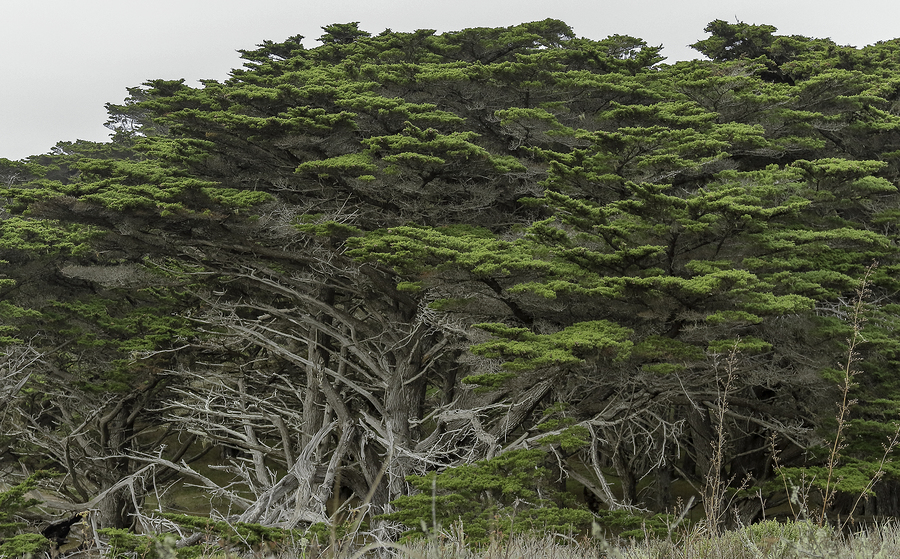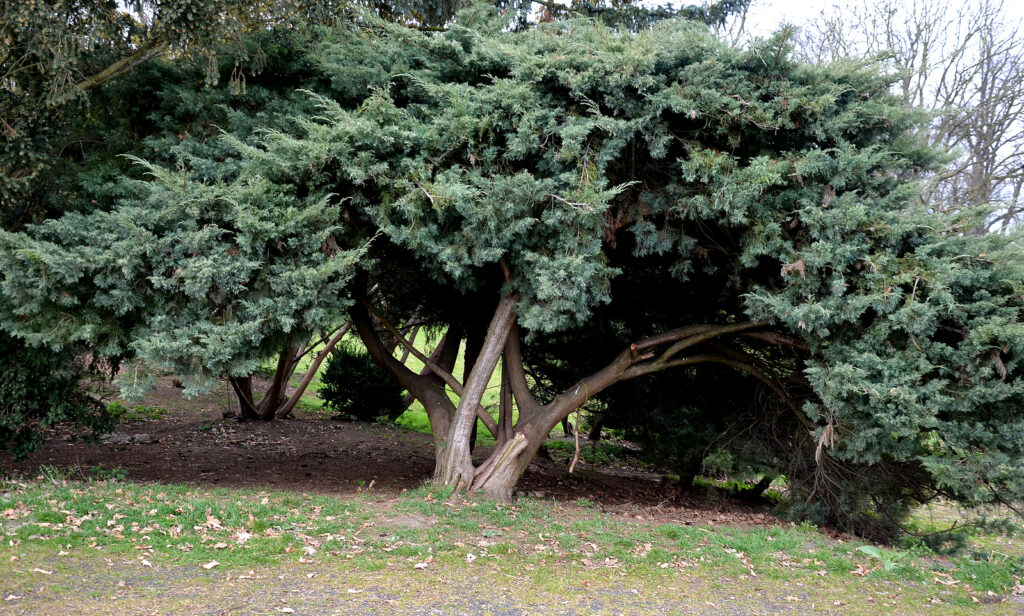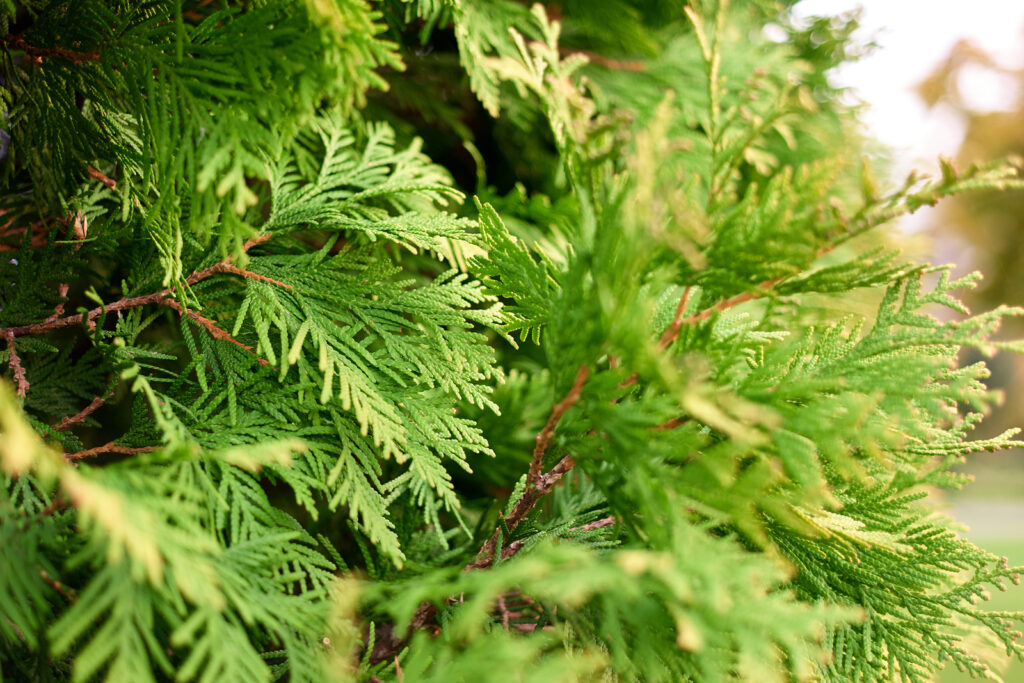Cupressus–commonly called Cypress–are evergreen, coniferous trees that grow tall. They are often grown as specimen trees and also as screens and hedges.
Cupressus grow 30 to 100 feet (10-30m) tall depending on the variety. Some grow narrow and columnar, others grow broad and flat-topped. All tolerate a range of soils from heavy to light, alkaline to acidic. All are drought tolerant once established. All tolerate heat and wind.
Cupressus have tiny scalelike leaves, closely set on cordlike branches, and interesting globular cones.
Cupressus is a genus of about 25 species belong to this genus. Cupressus is native to dry open hillsides in the Northern Hemisphere. They are found in the mild climates of the West and Southwest United States. They are short-lived in cold winter Eastern regions.

Get to know Cupressus
- Plant type: Evergreen trees
- Growing zones and range: Zones 6 to 10 depending on the variety
- Hardiness: Hardy to Zone 6
- Height and width: 30 to 100 feet (10-30m) tall depnding on the variety
- Foliage: Paired, overlapping, forward-pointing, scale-like leaves vary from rouned to pointed tips.
- Cones: Golf ball sized spherical to ovid female cones made up of shield-shaped scales ripen in the second year; green male cones are borne on shoot tips
- Uses: Specimen tree, hedge, screen
- Common name: Cypress, Monterey Cypress, Italian Cypress
- Botanical name: Cypress
- Family name: Cupressaceae
- Origin: Northern Hemisphere
Where to plant Cupressus
- Plant Cupressus in full sun.
- Grow Cupressus in any well-drained soil, including alkaline and acidic.
- Shelter Cupressus from cold drying winds, particularly when young.
When to plant Cupressus
- Set container grown or balled-and-burlapped Cupressus in the garden in spring or autumn.
Planting and spacing Cupressus
- Space Cupressus 12 to 40 feet (4-12m) apart depending on the variety.
How to water and feed Cupressus
- Cupressus grows best if the soil is kept just moist; mature trees can tolerate some drought.
- Fertilize Cupressus with an all-purpose, slow-release, organic fertilizer in spring.

Cupressus care
- Cupressus grown as a hedge can be trimmed in late spring; do not cut back into old wood.
Cupressus pests and diseases
- Cupressus can suffer canker, tip and branch dieback, root rot, and needle blights.
- Bark beetles, scale insects, caterpillars, and sawfly can attack Cupressus.
Cupressus propagation
- Sow Cupressus seed in a seedbed or in containers in a cold frame in spring.
- Root cuttings in lae autumn or early winter.

Cupressus varieties to grow
- Cupressus arizonica var. glabra. Smooth cypress, Arizona cypress. Fast-growing, pyramidal tree that reaches 35 feet taII and 15 to 20 feet wide, this species is cultivated only in the blue-leaved form; dense foliage of tiny, sharp-pointed, gray-green or blue-green, white-flecked scales that are pressed against the stems, creating ropelike branches; furrowed bark is shiny and reddish-brown and flaking; cones are about an inch around, larger than those of Chamaecyparis; excellent, fine-textured screen, windbreak, or specimen in a sunny, dry site. Cultivars include ‘Blue Ice’ a narrow, conical tree that grows to 30 feet tall and 8 feet wide with powder blue needles and red-tinged twigs; ‘Blue Pyramid’, a dense, blue-gray pyramid to 20 to 25 feet tall; ‘Gareei’, with silvery blue-green foliage; and ‘Pyramidalis’, a compact, symmetrical grower; ‘Carolina Sapphire’ has bright blue needles and a full shape and is very fast growing; ‘Glauca’ has blue-green foliage.
- C. macrocarpa. Monterey Cypress. Grows 40 feet tall and 30 feet wide; pyramidal shape with a spiky top when young, matures into a picturesque, flat-topped specimen with horizontal branches that reaches 40 feet tall and 30 feet wide; when grown along the coast, the tree takes on a rugged, windswept look; foliage consists of tiny, dark green, pointed scales that are closely pressed against the stems and borne in irregular sprays; aromatic leaves release a lemony scent when crushed; bark is reddish-brown and ridged. Cultivars include ‘Golden Pillar’ a dwarf that grows to is 15 feet tall; vertical fans of gold outer foliage and chartreuse inner foliage; ‘Horizontalis Aurea’ grows to 20-foot-tall; narrow column with golden foliage.
- C. sempervirens. Italian cypress. A narrowly conical or columnar tree grows to 70 feet tall and 20 feet wide; horizontal branches and dark green foliage. Cultivars include ‘Stricta’ (‘Fastigiata’), columnar Italian cypress; ‘Glauca’, blue Italian cypress is blue green in color; ‘Swane’s Golden’, another columnar form, has golden yellow new growth.



